Aomori and more
- Sort by
- Popularity
- Name
-
Tobe ware Tobe yaki
- Ceramic
- Ehime
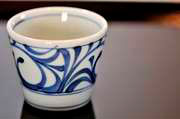
Tobe ware (called Tobe yaki in Japanese) is a form of ceramic ware produced around the town of Tobe in Iyo district of Ehime prefecture. Production began in the middle of the Edo period (1603-1868) and it was registered as a traditional craft by t…
View more
-
Satsuma ware Satsuma yaki
- Ceramic
- Kagoshima
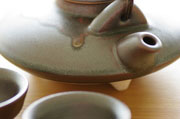
Satsuma ware (called satsuma yaki in Japanese) is a form of porcelain produced in Kagoshima prefecture. There are three types of Satsuma ware: white, black, and porcelain. Then there are six categories: tateno, ryumonji, naeshirogawa, nishimochida…
View more
-
Tsugaru lacquerware Tsugaru nuri
- Lacquerware
- Aomori

Tsugaru lacquerware (called tsugaru nuri in Japanese) is produced around the city of Hirosaki in Aomori prefecture. Lacquerware has been produced in this region since the middle of the Edo period (1603-1868), but it began to be called Tsugaru lacq…
View more
-
Takaoka copperware Takaoka doki
- Metal works
- Toyama
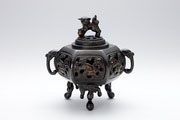
Takaoka copperware (called Takaoka doki in Japanese) is a type of copperware produced in the area around the city of Takaoka in Toyama prefecture. The various products range from small items such as indoor ornaments, Buddhist tools, and vases to l…
View more
-
Inami wood carvings Inami chokoku
- Wood, bamboo crafts
- Toyama
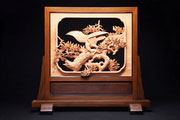
Inami woodcarvings (called Inami chokoku in Japanese) are produced in the city of Nanto, Toyama prefecture mainly in the form of transoms*, decorative objects, and single-leaf screens**. They are usually made of Japanese camphor, paulownia, or zel…
View more
-
Sakai cutlery Sakai uchihamono
- Metal works
- Osaka
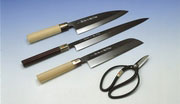
Sakai traditional blades are hammer-forged knives produced in the cities of Osaka and Sakai, Osaka prefecture. To achieve both strength and cutting quality, this craft is made by combining soft iron and steel. This craft is forged to have a sharp…
View more
-
Takaoka lacquerware Takaoka shikki
- Lacquerware
- Toyama
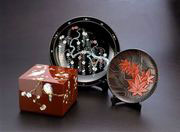
Takaoka lacquerware (called Takaoka shikki in Japanese) is produced in the area around the city of Takaoka, in Toyama prefecture. A defining feature of this lacquerware is the wide range of techniques and styles. Aogai-nuri is a technique that use…
View more
-
Banshu abacus Banshu soroban
- Writing tools
- Hyogo
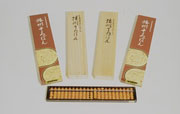
Banshu abacuses (called Banshu soroban in Japanese) are produced in the city of Ono, Hyogo prefecture. Ono, an agricultural area blessed with a warm climate, started abacus production during its off-season. Japanese abacuses are traditional tools…
View more
-
Tamba-tachikui ware Tamba tachikui yaki
- Ceramic
- Hyogo
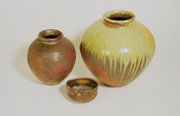
Tamba-tachikui ware (called Tamba-tachikui yaki in Japanese) is a form of pottery produced around Konda in the city of Sasayama, Hyogo prefecture. It is one of Japan's Six Ancient Kilns. Together with Bizen, Tamba, Echizen, Seto, and Tokoname…
View more
-
Izushi ware Izushi yaki
- Ceramic
- Hyogo
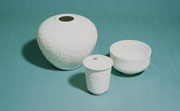
Izushi ware (called
View more
-
Osaka naniwa pewterware Osaka naniwa suzuki
- Metal works
- Osaka
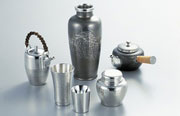
Osaka naniwa pewterware (called Osaka naniwa suzuki in Japanese) is a metalwork produced in and around the city of Osaka, Osaka prefecture. In the past, tin mined in Japan was used, but today it is imported mainly from Thailand and Indonesia. This…
View more
-
Honba oshima tsumugi silk Honba oshima tsumugi
- Woven textiles
- Kagoshima
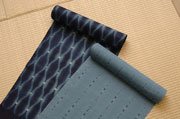
Honba Oshima Tsumugi is a fabric made on the island of Amami, Kagoshima prefecture. It is one hundred percent plain silk that has been dyed and made on handlooms like shime-bata or te-bata. This textile has deep, muted tones as it is dyed with ye…
View more
-
Osaka Buddhist altar Osaka butsudan
- Household Buddhist altars
- Osaka
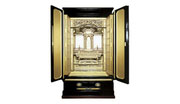
Osaka Buddhist altars (called Osaka butsudan in Japanese) are produced in the cities of Osaka, Yao, Higashiosaka, Sakai, and Kishiwada in Osaka prefecture. Along with the standard lacquer-painted, gold-leafed altars, this region is also known for …
View more
-
Ozu traditional Japanese paper Ozu washi
- Traditional Japanese paper
- Ehime
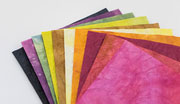
Ozu traditional Japanese paper (called Ozu washi in Japanese) is a handmade paper made in the town of Uchiko, Ehime prefecture. The history of papermaking of Ozu washi dates back to the Heian period (794-1185), and the current style of Ozu washi e…
View more
-
Echu traditional Japanese paper Echu washi
- Traditional Japanese paper
- Toyama
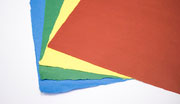
Etchu washi is traditional Japanese paper made in Asahi, Yatsuo, and Taira in Toyama prefecture. Each production area makes their own type of washi which are called Gokayama washi, Yatsuo washi, and Birudan washi. This craft has slight regional va…
View more
-
Osaka carved wooden panel Osaka ranma
- Wood, bamboo crafts
- Osaka

Osaka Transoms (called Osaka Ranma in Japanese) are transoms produced in and around the cities of Osaka, Kishiwada, and Suita in Osaka prefecture. In a Japanese-style house, transoms are wooden panels attached between the ceilings and lintels of t…
View more
-
Kawanabe Buddhist altar Kawanabe butsudan
- Household Buddhist altars
- Kagoshima
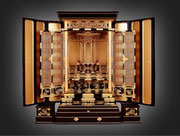
Kawanabe Buddhist Altars (called Kawanabe Butsudan in Japanese) are made in the Kawanabe area of Minamikyushu, Kagoshima prefecture. There is a specific type of altar called gamado that is unique to this craft. Gama means cave in the Kagoshima dia…
View more
-
Nibutani carved wooden tray Nibutani ita
- Wood, bamboo crafts
- Hokkaido
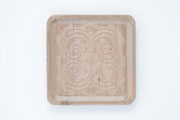
Nibutani Carved Wooden Trays (called Nibutani ita in Japanese) are produced in Biratori, Hokkaido. The origin of the town name, is an Ainu language word for cliff, pirauturu. This craft is known for its patterns like a spiral pattern called moreun…
View more
-
Nibutani bark cloth Nibutani attoushi
- Woven textiles
- Hokkaido
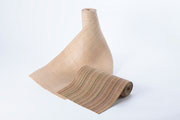
Nibutani Bark Cloth (called Nibutani-attushi in Japanese) is a bark fiber fabric produced in the region surrounding the the town of Biratori, Hokkaido. The term Nibutani originates from niputai which is an Ainu (indigenous people of north Japan) l…
View more
-
Banshu fly-fishing flies Banshu kebari
- Other crafts
- Hyogo
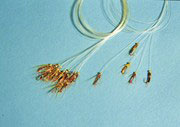
Banshu Kebari are fishing flies used as artificial-bait hooks for fishing, produced in Nishiwaki City, Hyogo Prefecture. They are characterized by their exquisitely fine workmanship; bird feathers wound with silk thread around a small 1cm hook, ad…
View more
-
Banshu-miki cutlery Banshu miki uchihamono
- Metal works
- Hyogo
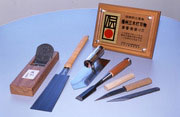
Banshu Miki Uchihamono are metalwork produced around Miki City, Hyogo Prefecture. Like Shinshu Uchihamono and Tosa Uchihamono, Banshu Miki Uchihamono is renowned as a craft made using molding techniques. These areas are also known as large product…
View more
-
Osaka karaki wood joinery Osaka karaki sashimono
- Wood, bamboo crafts
- Osaka
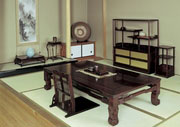
Osaka Karaki Wood Joinery, called Osaka Karaki Sashimono in Japanese, are wooden articles manufactured in several cities of Osaka Prefecture. Karaki is wood from trees mainly grown in Southeast Asia, and include rosewood, ebony, Chinese quince, an…
View more
-
Toyooka wicker crafts Toyooka kiryu zaiku
- Wood, bamboo crafts
- Hyogo
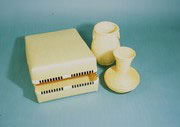
Toyooka Wicker Crafts, called Toyooka Kiryu Zaiku in Japanese, is wickerwork produced around Toyooka City, Hyogo Prefecture. The origins of the craft are found in the baskets woven from Salix koriyanagi, a species of willow naturally growing in th…
View more
-
Osaka bamboo screens Osaka kongo sudare
- Wood, bamboo crafts
- Osaka
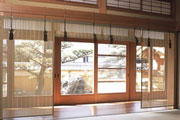
Osaka Kongo Sudare are bamboo blinds produced in the cities of Tondabayashi and Kawachi-Nagano in Osaka Prefecture. Tondabayashi City lies at the foot of Mt. Kongo, the highest mountain in Osaka, and good quality Japanese timber bamboo growing nat…
View more
-
Osaka-senshu traditional paulownia chest Osaka senshu kiri tansu
- Wood, bamboo crafts
- Osaka
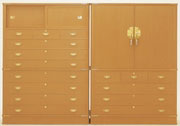
Osaka Senshu Kiri Tansu are wooden chests of drawers made in and around Kishiwada City and Sakai City, Osaka Prefecture. They are made from Paulownia wood, much appreciated for its durability, excellent moisture barrier properties and fire resista…
View more
-
Shogawa woodcraft Shogawa hikimono kiji
- Industrial art materials and tools
- Toyama
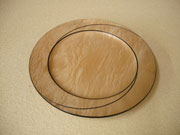
Shogawa woodcrafts are mostly woodcraft articles such as bowls or trays made in a wide area of the Toyama Prefecture including the city of Takaoka and the city of Tonami. Shogawa woodcrafts were designated as a traditional craft by the Ministry of…
View more
-
Etchu Fukuoka Sedge Hats Etchu Fukuoka no suge gasa
- Other crafts
- Toyama
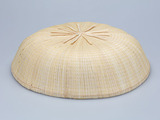
Etchu Fukuoka no suge gasa, Etchu Fukuoka Sedge Hats, are a traditional craft produced in Takaoka, Tonami, Oyabe, and Nanto of Toyama prefecture. The sedges produced in Fukuoka, Toyama are top quality as they survive the severe winters of the Hok…
View more
-
Izumi Glass Izumi garasu
- Other crafts
- Osaka
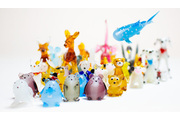
Izumi glass is known for its manufacturing method, lamp work where the glass is formed using a kerosene lamp (burner). Soft glass with a low melting point is used and the glass rods are melted by hand using the kerosene lamp. As the soft glass ena…
View more
-
Naniwa Honzome Hand Dyeing Naniwa honzome
- Dyed textiles
- Osaka
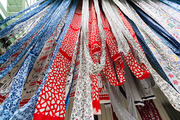
Naniwa Honzome Hand Dyeing is a traditional Japanese dyeing method, of which products are mainly produced in Sakai and Kashiwara, Osaka Prefecture. Osaka was a large producing center of Japanese hand towels called tenugui since the Edo period (160…
View more
- 1

































































































































































































































































































